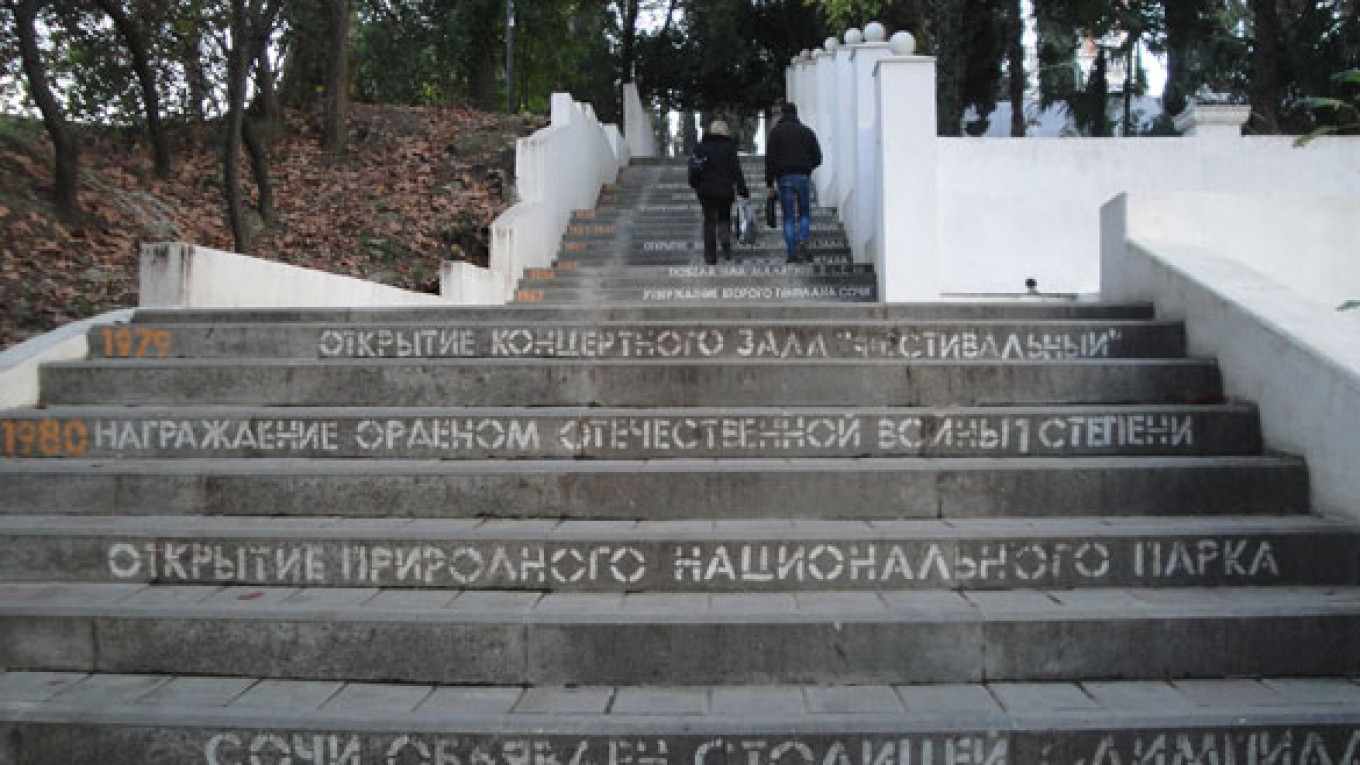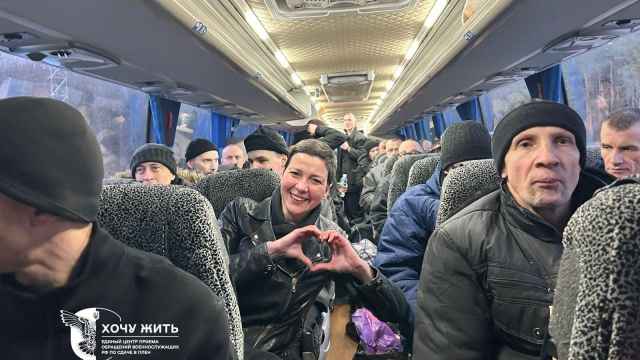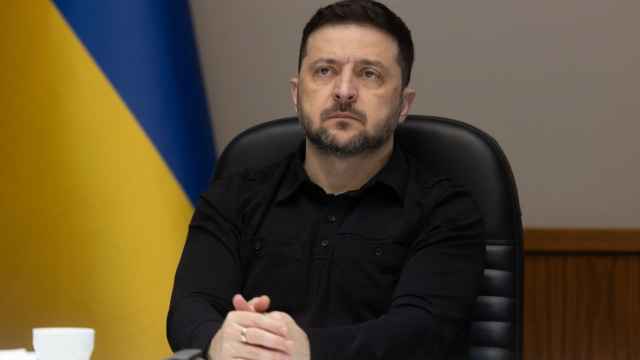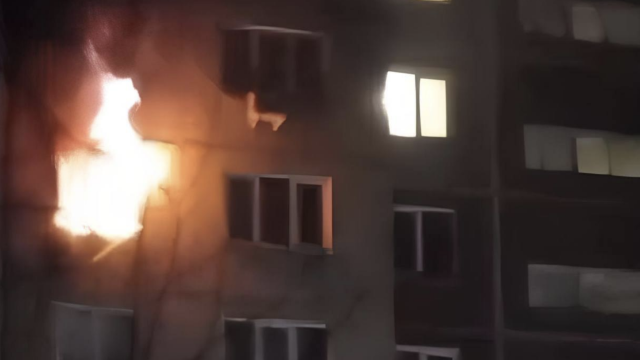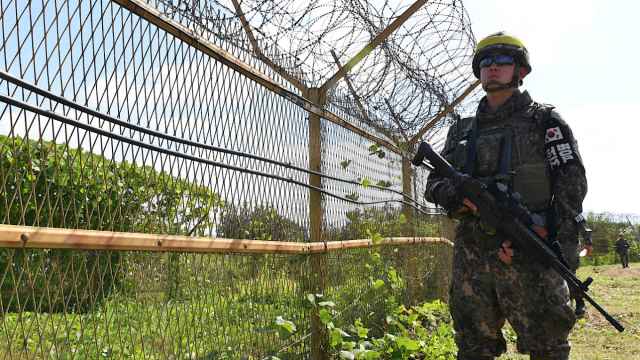Do not despair if you only have a couple of hours or one day in Sochi. Many of the city's most interesting attractions are located within walking distance of each other so, while one day will not be enough for you to fully enjoy Sochi, you will still see a lot and probably get to bask in the sun as well.
This particular route takes you along the signature sights of the resort city, pauses to remark on some historical turning points, and invites you to experience the flavor of the Russian south with a trip to the Central Market where acting like a local will eventually become second nature.
The route touches on several key events in Sochi's history, starting at the old and miraculously preserved weapons of the 19th century, which were made before the Black Sea coast territories were part of the Russian Empire; the Orthodox Cathedral built in honor of the Russians' victory in the Caucasian War; Stalin's ambitious projects to turn Sochi into a leading resort destination for Soviet workers; the tragedy and resurrection of the war; and the exuberance of youthful students in the post-war period that led to the city getting one of its best parks.
Anchor and Cannon Monument
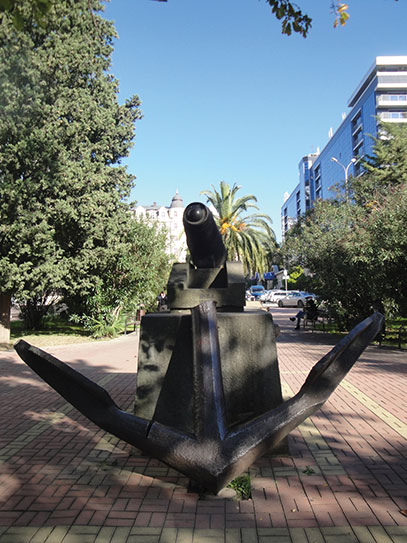
Primorskaya Ulitsa, Pushkinsky Skver
It is only fitting to begin exploring Sochi by the monument that stands as tribute to the foundation of the city. The Anchor and Cannon symbolize Russia's victory over Turkey in the 1828-1829 war. The peace agreement led to the Russians getting vast territories along the Black Sea coast, including the territory of modern day Sochi.
Both the cannon and the anchor were witnesses to the time that this historical document was signed. The cast-iron cannon, which previously diligently served its time in the navy, was made in 1807.
The anchor is even older, cast almost 100 years prior in a metallurgical town in the Urals. If you look closely, you can see the inscription with the exact year, month and day it was made. The metallurgists from the Urals were justifiably proud of their work. More than 230 years since its "birth," the anchor is still rust-free and appears less than stellar only on occasions when it is vandalized by exuberant football fans. But the anchor's eternal youth is not even the most remarkable thing about it. The corvette it was attached to sank after a big storm. Divers lifted the anchor back to shore in the early 20th century but then abandoned it on the beach, and it lay there long enough for the nearby area to be named in its honor. In 1912, the anchor was moved to Sochi where it was triumphantly united with the cannon amidst celebrations of Sochi's 75-year anniversary.
Pushkinsky Skver
Pushkinsky skver, between hotels Zhemchuzhina and Primorskaya
Take some time to stroll along the Pushkinsky Skver, east of the Anchor and Cannon monument. It is built a few meters higher than the bustling promenade so you are guaranteed outstanding views of the Black Sea. You can find a spot in the shadow or sun, enjoy a light breeze and meet with a wide array of locals. Young women meet here to talk about their boyfriends or strut in their nicest dresses in the hopes of getting boyfriends that they can later complain about. Older couples quarrel over newspaper headlines, and birds unashamedly flirt with each other, sometimes feigning great disappointment by jumping over the stone barrier and flying out to the water.
Seaport
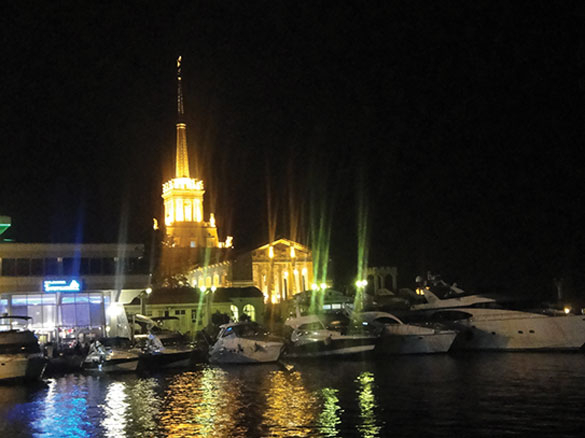
1 Ulitsa Voikova
Built in 1955, Sochi's seaport terminal looks more like a palace than a transportation hub and is one of the city's signature buildings. Even from far away you can navigate in the city by finding the spire on the port's tower. The spire is 36 meters high and crowned with a replica of the Order of the Patriotic War — the medal awarded to Soviet soldiers for their efforts in World War II.
The tower below has three levels of sculptures. On the lowest level are four 5-meter female figures that represent the seasons of the year. Above them are four male figures that point to the
different sides of the world, and the highest level is taken up by 12 dolphins, which symbolize the wealth of Russia's southern region.
The sculpture of a sea goddess, equipped with a compass and spyglass, reigns from a large fountain in front of the building. According to the initial design, the fountain was supposed to be installed on the opposite side so that the goddess' outstretched hand could helpfully direct sailors to the waterways, but because there was not enough room in the planned location, the stately figure now points to the park across the road and solemnly poses for tourist cameras.
There are two other fountains located on the premises though getting a glimpse at them has become harder since the seaport was transformed into a chic boutique mall. You can see some of the original interiors by going to the Chaika restaurant's banquet hall. The former waiting room on the building's second floor is filled with mirrors and decorated with majolica tin-glazed pottery and mosaics, including a soaring seagull on the ceiling.
The elaborate waiting room, along with the seaport as a whole, undoubtedly inspired awe among the Soviet workers who were lucky enough to snatch a cruise ticket from Sochi, much as it remains a fascinating relic for modern day visitors — perhaps even so for the Russian president and prime minister who anchor their yachts on the port's pier.
St. Michael's Cathedral
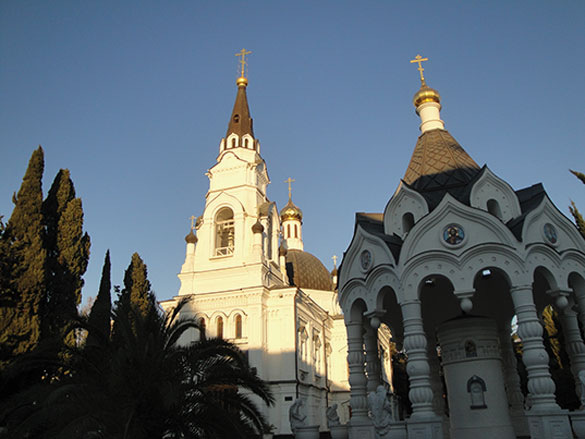
1 Ulitsa Ordzhonikidze
The architects of St. Michael's Cathedral would probably appreciate the swiftness of Olympics-related construction that plunged Sochi into a dust storm after its bid was proclaimed victorious. St. Michael's is the first and primary Orthodox church in the Black Sea district and was built in an effort to bring the mainland religion to the recently annexed Caucasus regions. Russian settlers were getting tempting invitations to the warm city but wanted assurances that they could uphold their religious traditions there. Political leaders responded with orders to build an Orthodox church. Its first stones were laid in 1874, a decade after the annexation of the North Caucasus to the Russian Empire. Unfortunately, the enthusiasm was not long-lasting, and the church was only completed in 1890.
But the drawn-out construction was nothing compared to what St. Michael's Cathedral endured later. Communists launched a campaign against the church after coming to power, and it was used as a storage facility from 1931 until the start of World War II when it was returned to parishioners.
The other buildings in the current, cat-friendly complex house a Sunday school and baptistery, while the park area holds a monument to the executed Tsar Nicholas II. The tsar chose to sail past Sochi when he was in the area, but as the Romanovs had property nearby, it was decided to put a statue here.
St. Michael is the patron saint of the city so you can see another tribute to him, a tall column with a statue on top, further west on Kurortny Prospekt.
Sochi History Museum
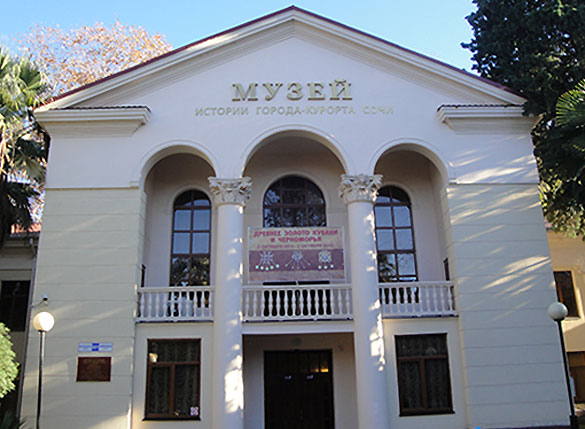
54/11 Ulitsa Vorovskogo
9 a.m. to 5:30 p.m. from September to May, closed on Mondays
9 a.m. to 7:30 p.m. from June to August
+ 7 (862) 264-2326
If you are hungry for more Sochi history, this museum will give you healthy portions on every possible topic. The museum's 12 halls hold more than 100,000 showpieces, many of which were brought in by local residents. The main themes covered in the exhibits include archaeological finds, the fertile environment of the North Caucuses, colorful residents of the Black Sea coast and — in a surprising move — space exploration. The museum offers English-language audio guides and, as a bonus, there is a cosy gated garden in front of the building with some anchors and statues on display. One of these statues is of a young girl holding a water pitcher. This is the original bronze monument that used to stand in a courtyard of the Central Railroad Station, the next point on our route.
Central Railroad Station
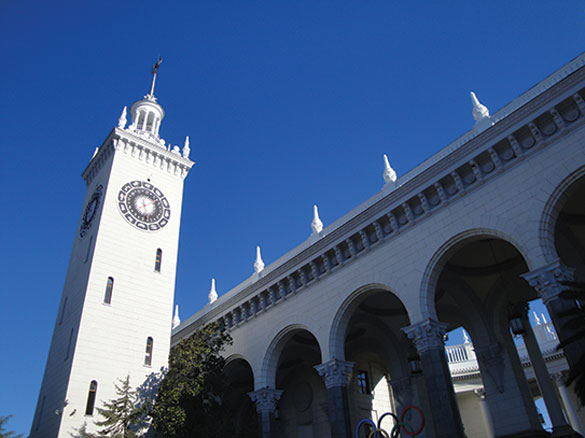
56 Ulitsa Gorkogo
Sochi's Central Railroad Station is the first impression that many tourists get of the southern resort and it can easily fulfill the grandest expectations. The station was built in the ethereal Italian palazzo style, with socialist realist and modern elements mixed in, and is now a UNESCO World Heritage site.
The station fulfills its practical mission well — trains coming and going at their set times — but there is nonetheless a side to this venue that defies all logic and reason. Take a look at the 55-meter watch tower and you will see a clock with zodiac signs around the dial. The zodiac signs are in the wrong order, and some are missing altogether. The architect, Alexei Dushkin, was rumored to be a member of an occult group so the mix-up is not accidental. Only the Leo, Virgo and Libra symbols are in order while Taurus, Scorpio and Aquarius are replaced with a swan, snake and hound dogs.
Dushkin's creativity did not go by unnoticed — or unpunished. Despite being one of Stalin's favorite architects and staying up at night to perfect the designs for the Sochi station, Dushkin was accused of defeatism and fired in 1955. The official version states that Dushkin was dismissed because his projects often exceeded their planned size and budget. In another version, the party elite got cross at the architect because he decided to put a statue of a young girl in the station's courtyard instead of Stalin's statue. It is not clear how accurate the latter version is, but Dushkin was known to shoot down the local workers' overly enthusiastic efforts to put up more bronze and clay decorations on the building.
Sochi's station has a twin in Ukraine's Simferopol, also designed by Dushkin, though this station is a year younger, smaller and its clock is missing a Libra sign.
Central Market
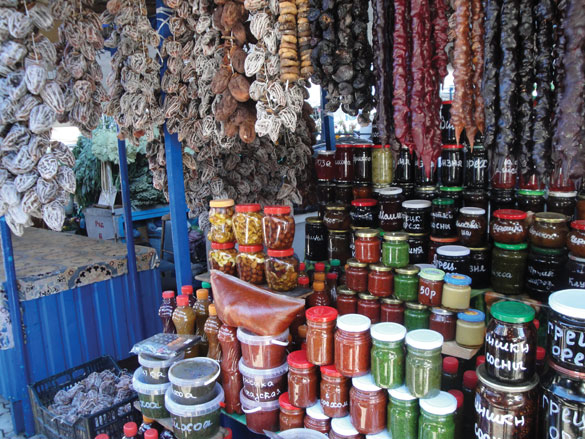
The Central Market is the bustling, colorful and at times overwhelming heart of Sochi life. Well-known pop songs from the 1990s blast from the stereo speakers, drawing out feelings of nostalgia for a time before shopping malls and shopping carts. Female vendors sneakily read celebrity tabloids behind their counters but are always alert enough to call out "sweetie," "beautiful" or "handsome" when a potential customer pauses to get his bearings in a bazaar that takes up a whole city block. Children play under the tables to pass the time until the closing bell.
Locals claim that the best products with the best prices are hidden in the back of the market and advise never to be too proud to haggle, if only for the fun of it. Although it is highly unlikely that you will meet a fluent English speaker here, gestures go a long way, as do the food samples, in getting exactly what you want and more.
It is easy to get disoriented in a market of this size. Here is a short guide to some items that you should consider buying or at least tasting while you are at the market:
Dried persimmon — Most abundant, and fresh, in late autumn, this desert is made by putting persimmons on a string and leaving them out to dry in the sun.
Marinades — Like jams, the variety of marinades can range from the very basic to daring concoctions made with bamboo, fern, green beans or corn.
Homemade jams — Depending on the season, you can find jams made out of familiar fruit or local delicacies like jams made from young pine cones, walnuts and feijoa. Be prepared to get a whole lecture on their medicinal properties, and nod politely when your own physical well-being is put under the spotlight.
Spices — What would the Caucasus region be without a wide selection of spices? Be sure to try tkemali, a tart Georgian sauce made out of cherry plums or for a spicier nudge go for ajika, which is commonly used in Abkhazia.
Churchkhela — This is a Georgian or Armenian candy made by stringing together nuts and dumping them in dense grape juice. There are multiple variations of this popular desert, which one street vendor described as the "Armenian Snickers," and can include dried fruits, pomegranate or apple juice. If you like the flavor, also try pastilla made out of dried fruits.
Lavash — Don't leave without trying some lavash, but don't compromise on the demand that it should be fresh out of the oven. This local alternative of pita bread can now be found in any Russian city, but people from the country's southern regions pride themselves on having the best bakers and recipes. And when bread is taken out of the oven, you'll not only smell it but also see people nearby drop whatever they are doing to get in line. You should too.
War Memorial
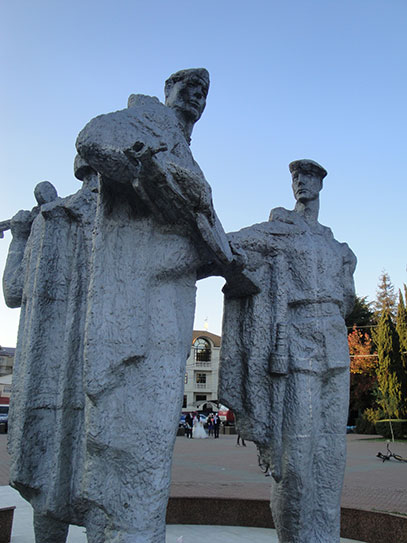
Sevastopolskaya Ulitsa
The grounds of the current War Memorial used to be a cemetery for Soviet soldiers who died in Sochi's hospitals during World War II. More than 2,000 soldiers and war victims were buried here until a proper memorial was erected in time for the 40th anniversary of Germany's surrender.
Though it may first seem to be rather formal and cold, the memorial is actually very personal. The local architect who designed it, Grigory Nazaryan, took part in the war effort, and the eternal flame in the middle of the complex also brings back many memories. It was lit from the fire taken from Malaya Zemlya, a Soviet uphill post near Novorossiysk where a 274-strong Soviet naval infantry contingent fought with the German forces in February 1943.
Sochi residents are very protective of this memorial. Construction on a high-rise building started nearby in 2012, but the locals protested and got the structure demolished.
Komsomolsky Skver
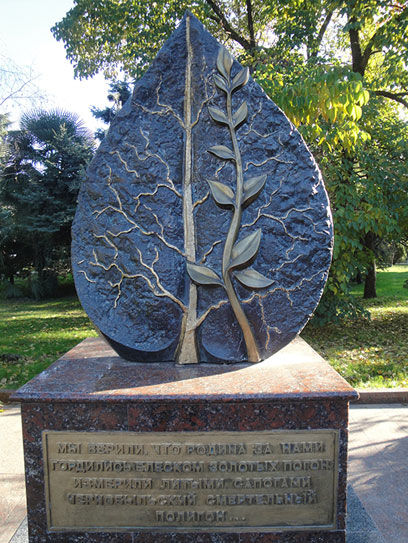
Kurortny Prospekt at the crossing of Ulitsa Konstitutsii SSSR and Neserbskaya Ulitsa
One of the central parks in the city, Komsomolsky Skver is a fascinating tribute to the resilience of Soviet youth brigades. It was drawn up by a graduate university student and turned into reality by another group of students who volunteered on their weekends to build it. These students belonged to the Soviet youth political organization, Komsomol, and managed to turn the area into a park within a year, between 1969 and 1970.
The park's most interesting feature is the Two Anchors fountain, made up of real anchors that were cast in the first half of the 19th century and used on Russian naval ships. Historians believe that these ships sank in a heavy storm in 1838 between Sochi's Khosta and Kudepsta districts. Divers lifted them from the sea bottom in the early 1960s, and now they are centerpieces in one of the city's most popular locations for daytime and evening strolls.
Lenin's Mosaic
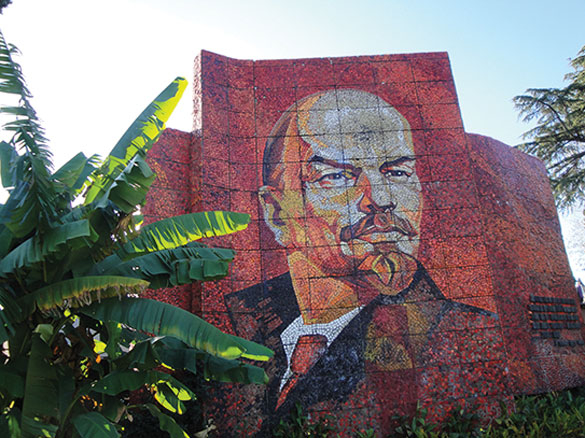
Ulitsa Yegorova by the turn to Rivyersky Pereulok
The traditional full-length statue of the communist revolutionary Vladimir Lenin can be found on Art Square. It was triumphantly installed there in 1957 to celebrate 40 years of the October Revolution and is still witness to the exuberant celebrations that happen in the city center. The artistic route that is outlined in this guide gives you the opportunity to look at the statue, but perhaps the more interesting piece, at least in terms of artistry, is the mosaic portrait of the legendary Bolshevik that was put up near Riviera Park in 1980. The mosaic shows Lenin in his prime, set against a red backdrop and looking boldly into the future. Its installation date is also symbolic as it coincided with the leader's 110th birthday. Now it will be up to you to decide which birthday present would have pleased Lenin more.
Feat for Life Memorial
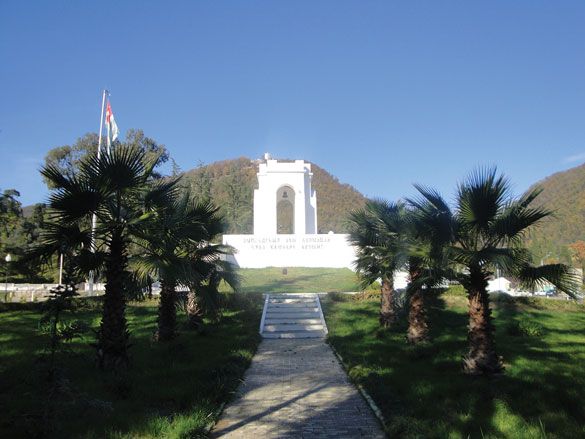
Rivyersky Pereulok
This touching memorial is dedicated to Sochi's medical staff who aided in the recovery of 400,000 wounded people during the Great Patriotic War when the country's primary resort transformed practically overnight into a key hospital town. A little more than a month after the German invasion, Sochi already had 11,980 hospital beds. All residents took part in getting the hospitals ready, scrubbing the floors or making the bed sheets and clothes for the ill. The first wounded soldiers started arriving on Aug. 5. The best sanatoria, doctors and Matsesta's healing waters were used to bring them back on their feet.
Construction of the memorial to the unspoken heroes of the war — doctors and nurses — began in 1981, but the site opened only in 1995, in time for the 50th anniversary of the war. It is the only monument to wartime medics in Russia and shows a nurse kneeling by a wounded soldier as the doctor prepares to perform surgery.
The original design was more ambitious in scale and meaning but was never fully completed. In addition to the main figures, there were supposed to be a cross on the arc, a marble stele with text about the meaning of the monument, and another with the names of the local hospitals and leading surgeons. These features were abandoned because of the shaky political and economic situation of the 1990s.
The city's administration returned to the project in 2010 and installed fountains along the alley leading to the monument. However, some criticized the addition for contradicting the original design. The memorial was supposed to have an unending spring of living water that would flow into a quiet pool, while the fountains were seen by some to be too frivolous.
A Message from The Moscow Times:
Dear readers,
We are facing unprecedented challenges. Russia's Prosecutor General's Office has designated The Moscow Times as an "undesirable" organization, criminalizing our work and putting our staff at risk of prosecution. This follows our earlier unjust labeling as a "foreign agent."
These actions are direct attempts to silence independent journalism in Russia. The authorities claim our work "discredits the decisions of the Russian leadership." We see things differently: we strive to provide accurate, unbiased reporting on Russia.
We, the journalists of The Moscow Times, refuse to be silenced. But to continue our work, we need your help.
Your support, no matter how small, makes a world of difference. If you can, please support us monthly starting from just $2. It's quick to set up, and every contribution makes a significant impact.
By supporting The Moscow Times, you're defending open, independent journalism in the face of repression. Thank you for standing with us.
Remind me later.


